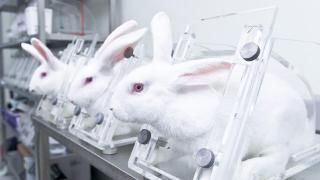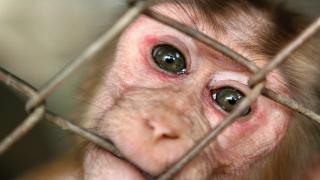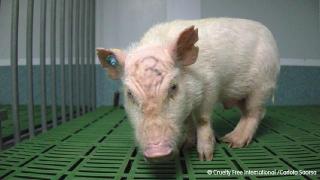Millions of animals are used and killed in scientific procedures every year.
Globally.
- We estimate that at least 192.1 million animals were used for scientific purposes worldwide in 2015. This is the world’s most reliable figure to date.
- This includes nearly 80 million experiments on animals as well as millions of other animals who are killed for their tissues, used to breed genetically modified animal strains and bred but not used.
- We estimate that the top 10 animal testing countries in the world are China (20.5 million) Japan (15.0 million), the United States (15.6 million), Canada (3.6 million), Australia (3.2 million), South Korea (3.1 million), the United Kingdom (2.6 million), Brazil (2.2 million), Germany (2.0 million) and France (1.9 million), in that order.
- In 2015, an estimated 207,724 tests using dogs and 158,780 tests using monkeys were conducted.
- The top 10 users of dogs were: China, the United States, Canada, South Korea, Japan, Australia, Brazil, the United Kingdom, Germany and India.
- The top 10 users of monkeys were: the United States, China, Japan, Brazil, Canada, the United Kingdom, France, Germany, India and South Korea.
Europe
- The latest report from the European Commission shows that 9.3 million experiments were conducted on animals across the EU and Norway in 2022.
- An additional 9.6 million animals were bred and killed, but not used in experiments. This means that in 2022, a total of 18.9 million animals were used for scientific purposes in the EU.
- The total number of uses decreased by 8% from 2021 to 2022, but the number of tests has risen by 7% since 2020.
- France conducted the highest number of animal uses in Europe in 2022 (2.1 million). Germany was the second highest user completing 1.7 million uses in 2022, while Norway was third with 1.4 million uses that year.
- There were 14,395 uses of dogs in 2022 with France (3,934 uses), Germany (2,873 uses) and Spain (1,511) being the top three users.
- There was a total of 7,658 uses of monkeys across the EU in 2022 with France (4,147 uses), Germany (2,204 uses) and Spain (703 uses) being the top three users.
- Out of the total number of animal uses in the EU in 2022, 33% were for basic research purposes while only 12% were required by regulators.
- Of the 9.3 million uses of animals in 2022, 49% were considered by researchers to have caused moderate or severe suffering to the animals involved.
- Experiments are still being conducted for regulatory purposes in the EU where there are valid non-animal methods available.
- In 2022, there were 3,824 skin irritation tests, 383 eye irritation tests, 33,029 skin sensitisation tests, 19,168 pyrogenicity tests and 152,642 batch potency tests on mice to meet the requirements of human medicines legislation (a large proportion of which were likely to be tests for botox products). See more.
UK
- According to the latest Government figures, a total of of 2.68 million (2,681,686) procedures on animals were completed in Great Britain in 2023 - a decrease of only 3% on 2022.
Of those 2.68 million:
-
Severe or moderate pain, causing the most suffering and distress, and even death – 18% (495,658)
-
Creation and breeding of genetically altered animals – 45% (1.21m)
-
Basic curiosity-driven research – 29% (769,865)
-
Translational research to develop treatments or cures for diseases – 14% (368,685)
-
Regulatory testing, to assess the safety or effectiveness of products – 9% (246,163)
-
Routine production, for antibodies, etc. – 2% (59,222)
Tests on species:
-
Horses – 39% rise (11,409)
-
Cats – 38% fall (63)
-
Dogs – 9% fall (3,770)
-
Monkeys – 1% fall (2,169)
-
Rabbits – 1% rise (8,936)
- Tests highlighted in our UK Replace Animal Tests (RAT) List continued in 2023, despite having approved non-animal replacements. This includes skin irritation tests on rabbits (2023 saw an increase from zero to 3), eye irritation tests on rabbits (three to seven) and skin sensitisation tests on animals (248 to 296, an increase of 19%).
- We celebrate that, for the first time, zero skin irritation tests on animals were conducted in GB in 2022. Last year we celebrated that, for the first time, zero eye irritation tests on animals were conducted on animals in 2021. Sadly, 2022 saw three eye irritation tests on rabbits, demonstrating that this use has not ended completely.
INFORMATION ABOUT ANIMAL EXPERIMENTS CAN BE EXTREMELY COMPLICATED AND VIEWS OFTEN DIFFER. WHAT APPEARS ON THIS WEBSITE REPRESENTS CRUELTY FREE INTERNATIONAL EXPERT OPINION, BASED ON A THOROUGH ASSESSMENT OF THE EVIDENCE.
FIND OUT MORE ABOUT ANIMAL TESTING
Alternatives to animal testing
subtitle: Alternatives to animal tests are often cheaper, quicker and more effective.
Our History
subtitle: Established in 1898, Cruelty Free International is firmly rooted in the early social justice movement and has a long and inspiring history.
What is animal testing?
subtitle: Animals used in laboratories are deliberately harmed, not for their own good, and are usually killed at the end of the experiment.
Arguments against animal testing
subtitle: Animal experiments are cruel, unreliable, and even dangerous.
Types of animal testing
subtitle: Animal testing is carried out in a wide range of areas, including biological research, and testing medicines and chemicals.
Alternatives to animal testing
subtitle: Alternatives to animal tests are often cheaper, quicker and more effective.






